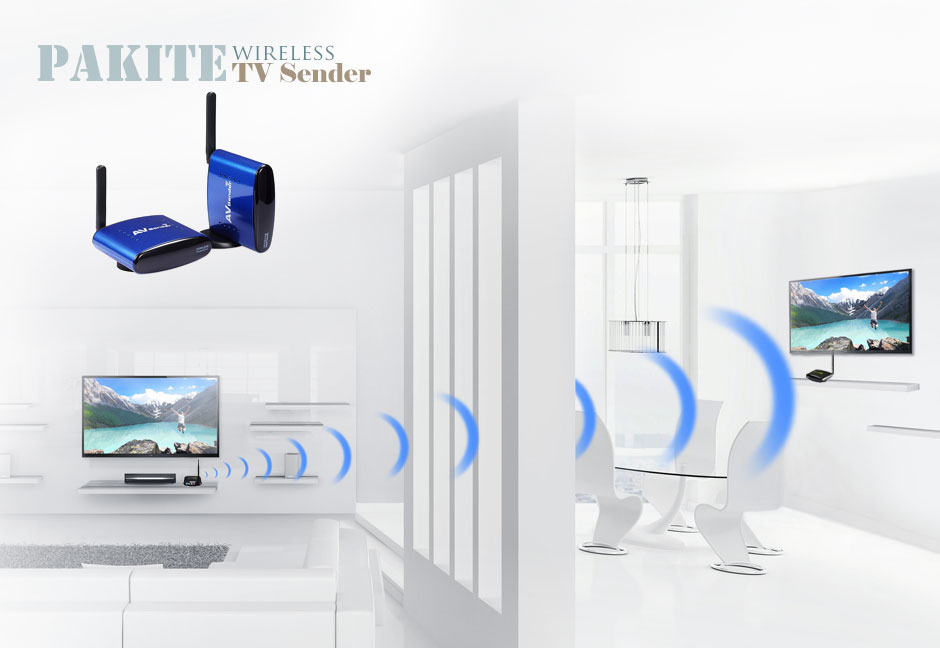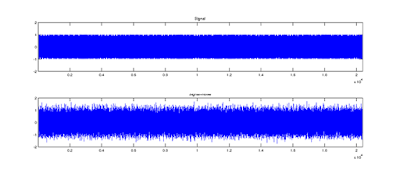Recommend reading:
Official site: www.pakite.com. How To Guides
Follow: Flickr(Phones Watches) . Flickr . Youtube(Watches) and QQ live(Electronic) online.
Monday, February 27, 2017
What is a wireless video transceiver? How to share a cable box signal to many sets of TV?
Recommend reading:
Sunday, February 26, 2017
PAKITE PAT-266 Wireless AV Sender with IR Remote Control | PAKITE
Wireless make connection become much easy, we make wireless connection become more popular. PAT-266 make av signal transmission much easier.
Friday, February 24, 2017
What’s the difference between 2.4ghz and 5.8ghz? | PAKITE
Wednesday, February 22, 2017
Smart wireless tv sender installation | PAKITE
 b. Keep IR Remote control frequency
band F1/F2 should be same, normal F1 is 38KHz frequency band and F2 is 56KHz
frequency band.
b. Keep IR Remote control frequency
band F1/F2 should be same, normal F1 is 38KHz frequency band and F2 is 56KHz
frequency band.Take you to understand PAT-580 | PAKITE
HDMI Jack is widely used at all of device, like PC, Camera,TV, Satellite Receiver, DVD and so on. Then the quantity demanded of wireless HDMI transmitter become more and more.
PAT-580 is new reach of PAKITE Technology, it’s a favorable products for those HDMI user.
Transmitter:
 PAT-580 Transmitter support 480P,576P,720P,1080I,1080P@60Hz as input resolution. At transmitter end, there is one group HDMI input and one group HDMI output. The HDMI input group is for connect DVD or other signal source with transmitter, the HDMI output group is for connect with TV directly. Which means one transmitter and one receiver support connect with two sets tv.
PAT-580 Transmitter support 480P,576P,720P,1080I,1080P@60Hz as input resolution. At transmitter end, there is one group HDMI input and one group HDMI output. The HDMI input group is for connect DVD or other signal source with transmitter, the HDMI output group is for connect with TV directly. Which means one transmitter and one receiver support connect with two sets tv. PAT-580 Receiver support 576P resolution as output resolution, whatever input resolution is 720P or 1080P, the receiver will automatic change the output resolution as 576P. The receiver should be placed at within 10-15 meters after passed one wall, or it will cause unstable transmission.
PAT-580 Receiver support 576P resolution as output resolution, whatever input resolution is 720P or 1080P, the receiver will automatic change the output resolution as 576P. The receiver should be placed at within 10-15 meters after passed one wall, or it will cause unstable transmission.PAT-580 HDMI av sender is stand at the mid side between RCA Jack av sender with 480P resolution and HDMI Jack av sender with 1080P resolution. It’s function still keep the RCA one, like one transmitter and many receivers, like 300 Meter long range transmission.
Tuesday, February 21, 2017
Video Transmitters for Wireless Analog CCTV System
Wireless Cable TV Audio/Video Transmission Systems
What is a wireless video transceiver? How to share a cable box signal to many sets of TV?
Monday, February 20, 2017
Why my a/v transmitter receiver can not work well?
Sources: Why my a/v transmitter receiver can not work well?
Wireless product is a magical product. You test it, it can not work, but I test it, it working prefect. But why?
If the av sender can not work as normal, we should contact with seller ask for solution nor return the goods and complain the quality is not good, that’s make both seller and buyer fells unhappy. PAKITE would like to eliminate your negative emotion and come out solution for you.
Here we talked about the RCA and HDMI av sender transmit audio but no video or transmit video but no audio. If you meet that questions.
First: please double check all cable connection is correct, if your av sender is connect with signal or monitor by RCA Cable, then you have to plug the red yellow white cable with corresponding color jack. please noted: red , blue, green is not RCA Jack, it’s different signal source.
Second: please double check both transmitter and receiver cable connection is no loosen, if still not work, you can try to change another av cable.
Third: this condition is rare, but still exist. Some of satellite receiver has HDMI Jack and RCA/ S-video Jack, so user will connect one set tv with satellite receiver by HDMI Jack, at same times connect transmitter with satellite receiver, which means the satellite receiver has two group av output, but some of satellite receiver do not support two group av signal out put at the same times, that will lead to another tv at receiver end no audio or video signal, even if make the receiver can not work. If you meet the third situation, you just need one transmitter with two receiver, it will be workable.
Any other questions about wireless av sender, welcome leave message with us.
Recommend reading:
Wireless Cable TV Audio/Video Transmission Systems
New Opportunity on PAT-580 HDMI Wireless | PAKITE
PAKITE PAT-266 Wireless AV Sender with IR Remote Control
Friday, February 17, 2017
Wireless Video Transmitters
 A video sender (also known as wireless video sender, AV sender or audio-video sender) is a device for
transmitting domestic audio and video signals wirelessly from one location to another. It is most
commonly used for sending the output of a source device, such as a set top box,
DVD player, CCTV camera, DVR, blu-ray player, satellite television decoder, to a television or viewing device in another part of a property and provides an
alternative to cable installations. There are two types of interface:
RCA or AV and HDMI. HDMI av sender is for transmitting HDMI signal wireless, and
there are two types output resolution of a HDMI wireless a/v sender: 576p and
1080p. 576p HDMI av sender is the new wireless av product which launched by
PAKITE at 2016. Following is something about wireless video transmitters.
A video sender (also known as wireless video sender, AV sender or audio-video sender) is a device for
transmitting domestic audio and video signals wirelessly from one location to another. It is most
commonly used for sending the output of a source device, such as a set top box,
DVD player, CCTV camera, DVR, blu-ray player, satellite television decoder, to a television or viewing device in another part of a property and provides an
alternative to cable installations. There are two types of interface:
RCA or AV and HDMI. HDMI av sender is for transmitting HDMI signal wireless, and
there are two types output resolution of a HDMI wireless a/v sender: 576p and
1080p. 576p HDMI av sender is the new wireless av product which launched by
PAKITE at 2016. Following is something about wireless video transmitters.
2.4GHz
Video Transmitters
2.4GHz
Wireless Video Transmitters are an inexpensive solution for sending security
camera video wirelessly. There are two types of 2.4GHz video transmitters. The
first are analog video transmitters that use RF signals to transmits video and
require line of sight with no obstructions between the transmitter and
receiver. The 2.4GHz analog video transmitters are great for solutions where
Real Time video is required without any lag, or where the signal must be
received at multiple receivers. The second type are digital wireless 2.4GHz
transmitters that utilize a WiFi like signal modality which allows penetration
through obstructions based on their density and strength of the transmitted
signal. It is possible to penetrate a solid concrete wall or thin sheet metal
wall using a 2.4GHz digital wireless transmitter and a 2.4GHz 16dbi high gain
panel antenna.
5.8GHz Video Transmitters
5.8GHz Wireless Video Transmitters allow for long range video transmission without interference from
WiFi. At CCTV Camera World we specialize in wireless video transmission, and
sell only FCC certified video equipment that conforms to all Federal
regulations. The analog 5.8GHz video transmitter can be used along with its
5.8GHz wireless receiver to send video signals. This 5.8GHz wireless video transmitter is great for converting a wired
security camera in to wireless because it transmits a Real Time video signal
without any frame drops or choppiness. Video quality is almost as good as
wired, as long as signal transmission occurs in line of sight and the proper
types of antennas are used to maintain good signal strength.Recommend reading:
New Opportunity on PAT-580 HDMI Wireless
How to select a worthy TV to TV Sender
What’s the difference between 2.4ghz and 5.8ghz? | PAKITE
Wednesday, February 15, 2017
What is HDMI AV Transmitters and Receivers? | PAKITE
 Right now, HDMI Connection become the
mainstream interface, so Wireless HDMI Transmitter and Receiver comes with HDMI interface. So,
What is HDMI wireless av transmitter?
Right now, HDMI Connection become the
mainstream interface, so Wireless HDMI Transmitter and Receiver comes with HDMI interface. So,
What is HDMI wireless av transmitter? Tuesday, February 14, 2017
Wireless Cable TV Audio/Video Transmission Systems

- Read also, send TV signal wireless to another TV room to room
- Read also, How to Convert Cable TV to Wireless Eliminate the trouble of complicated wiring?
Monday, February 13, 2017
New Opportunity on PAT-580 HDMI Wireless | PAKITE
Recommend reading:
How can I watch difference channels by audio/video transmitter receiver?
Compare Wireless TV Sender Model PAT-220 and PAT-330
Video Transmitters for Wireless Analog CCTV System
Saturday, February 11, 2017
How to select a worthy TV to TV Sender
How a TV Sender Works
 To make an informed decision when it comes to buying a TV to TV Sender, the buyer must first understand how a TV Sender works. A TV sender is connected to the main television by way of a SCART socket. The SCART socket is the largest socket located on the back of the television.
To make an informed decision when it comes to buying a TV to TV Sender, the buyer must first understand how a TV Sender works. A TV sender is connected to the main television by way of a SCART socket. The SCART socket is the largest socket located on the back of the television.Types of TV Senders
Low-Definition, 2.4GHz
High-Definition, 5.8 GHz
Remote Control Extender
AV Sender | Transmission range | Signal Quality | Cost |
|---|---|---|---|
Low-definition, 2.4 GHz
|
Low
|
Depending on surrounding wireless devices
|
Inexpensive
|
High-definition, 5.8 GHz
|
High, extending to 9 m with remote control extender
|
Suffers little interference from surrounding wireless devices
|
Expensive
|





